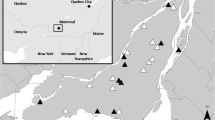Abstract
Evidence for interspecific competition between honey bees and wild bees was studied on 15 calcareous grasslands with respect to: (1) foraging radius of honey bees, (2) overlap in resource use, and (3) possible honey bee effects on species richness and abundance of flower-visiting, ground-nesting and trap-nesting wild bees. The grasslands greatly differed in the number of honey bee colonies within a radius of 2 km and were surrounded by agricultural habitats. The number of flower-visiting honey bees on both potted mustard plants and small grassland patches declined with increasing distance from the nearest apiary and was almost zero at a distance of 1.5–2.0 km. Wild bees were observed visiting 57 plant species, whereas honey bees visited only 24 plant species. Percentage resource overlap between honey bees and wild bees was 45.5%, and Hurlbert’s index of niche overlap was 3.1. In total, 1849 wild bees from 98 species were recorded on the calcareous grasslands. Neither species richness nor abundance of wild bees were negatively correlated with the density of honey bee colonies (within a radius of 2 km) or the density of flower-visiting honey bees per site. Abundance of flower- visiting wild bees was correlated only with the percentage cover of flowering plants. In 240 trap nests, 1292 bee nests with 6066 brood cells were found. Neither the number of bee species nor the number of brood cells per grassland was significantly correlated with the density of honey bees. Significant correlations were found only between the number of brood cells and the percentage cover of shrubs. The number of nest entrances of ground-nesting bees per square metre was not correlated with the density of honey bees but was negatively correlated with the cover of vegetation. Interspecific competition by honey bees for food resources was not shown to be a significant factor determining abundance and species richness of wild bees.
Similar content being viewed by others
Author information
Authors and Affiliations
Additional information
Received: 22 March 1999 / Accepted: 24 September 1999
Rights and permissions
About this article
Cite this article
Steffan-Dewenter, I., Tscharntke, T. Resource overlap and possible competition between honey bees and wild bees in central Europe. Oecologia 122, 288–296 (2000). https://doi.org/10.1007/s004420050034
Issue Date:
DOI: https://doi.org/10.1007/s004420050034




